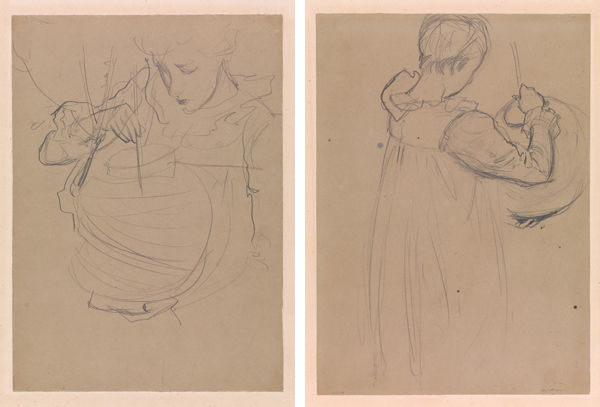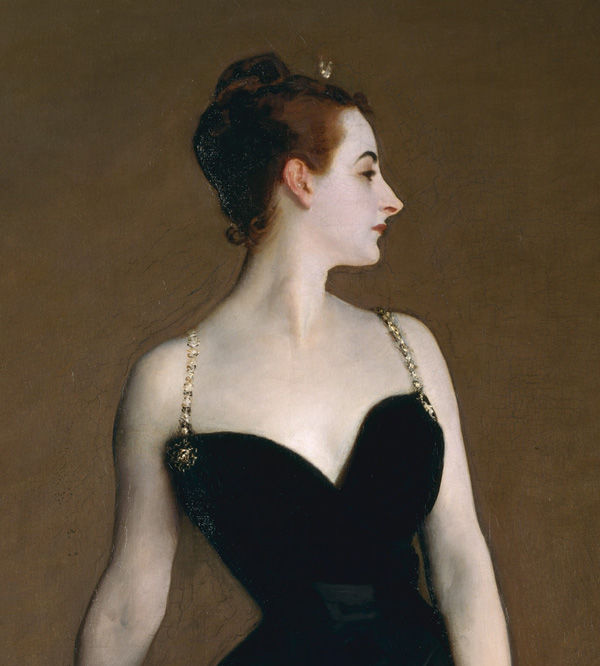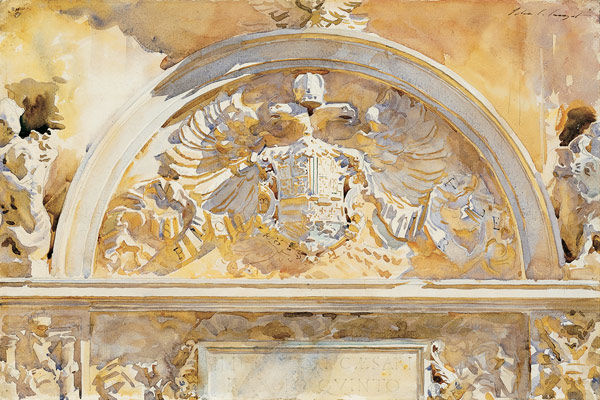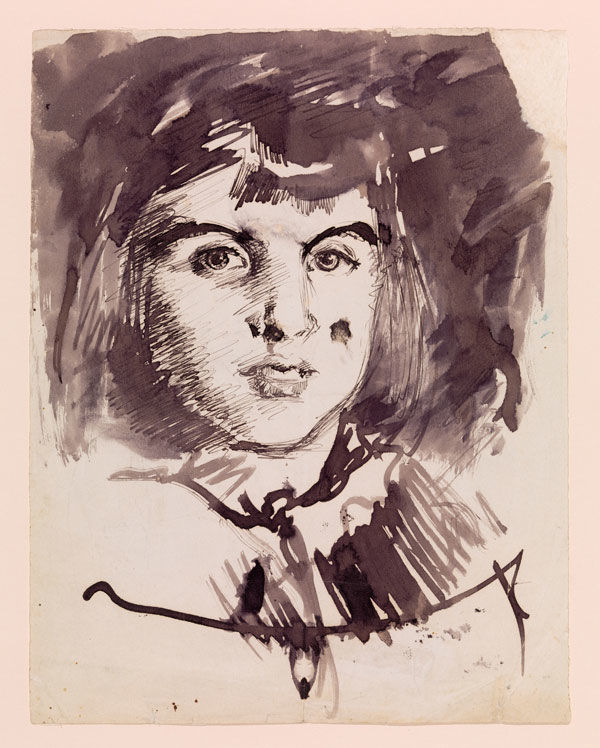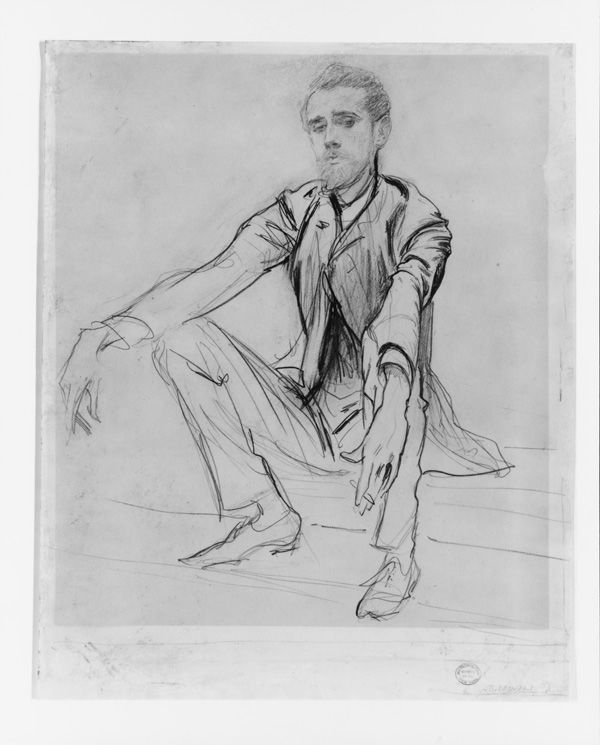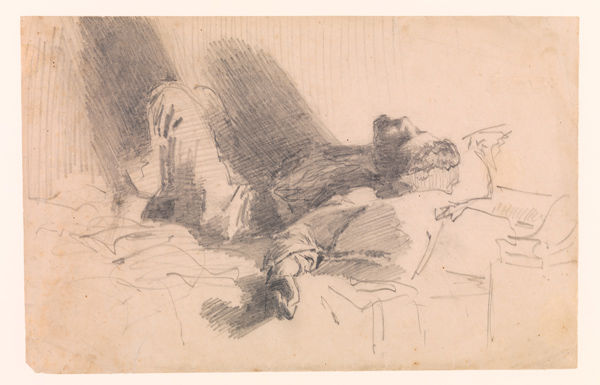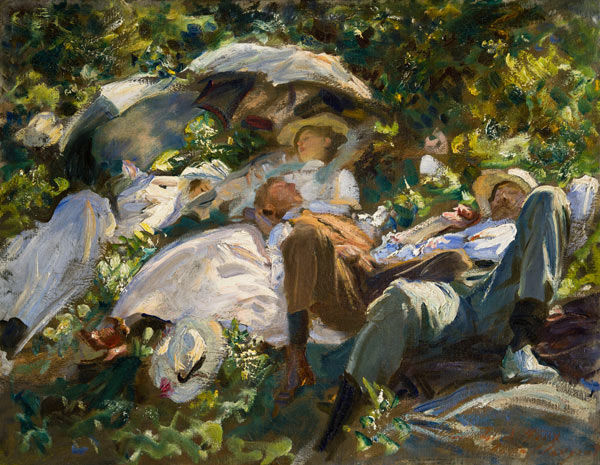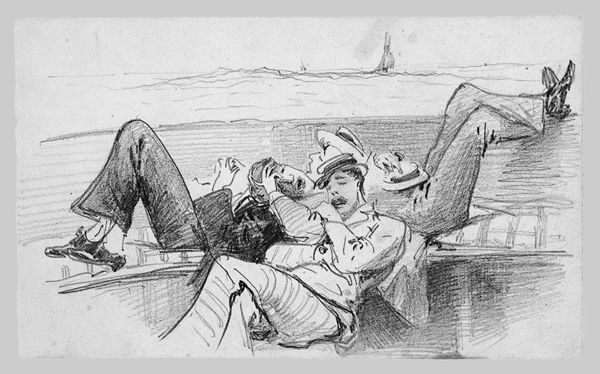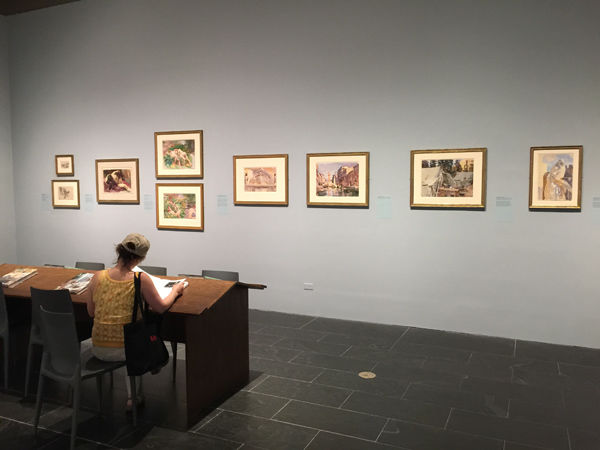
A visitor in the exhibition's reading room
Visitors to Sargent: Portraits of Artists and Friends will notice a special feature in the exhibition's reading room: an installation of twenty-one drawings and watercolors by John Singer Sargent from the Metropolitan Museum's extensive holdings. Chosen to complement the themes of the exhibition, these works represent the wide range of Sargent's efforts on paper. They reveal his technical brilliance as a watercolorist and draftsman, the diversity of his oeuvre during more candid moments, and his sensuous appreciation of the human figure—especially that of the male.
The Met's collection of Sargent's work is one of the largest and most comprehensive in the world. Nearly every aspect of the artist's prolific career is represented by forty-one oil paintings, more than three hundred works on paper, and four sketchbooks. Each of the five sections of the exhibition features at least one work from the Met—such as the monumental paintings Madame X and Ada Rehan, or the more incidental sketches After "El Jaleo" and Jane de Glehn, Study for "In the Generalife," among others.
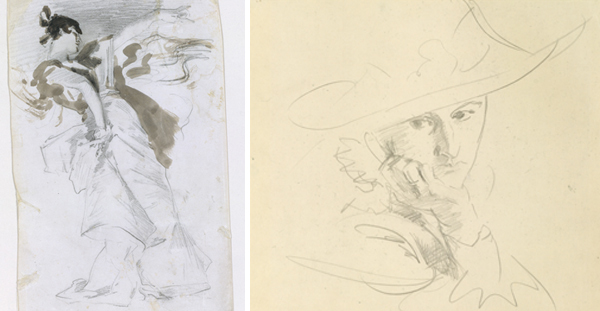
Left: John Singer Sargent (American, 1856–1925). After "El-Jaleo" (detail), ca. 1882. Graphite and watercolor on prepared clay-coated paper; 10 1/8 x 5 1/2 in. (25.7 x 14 cm); storage (mat size): 19 1/4 x 14 1/4 in. (48.9 x 36.2 cm). The Metropolitan Museum of Art, New York, Gift of Mrs. Francis Ormond, 1950 (50.130.139). Right: John Singer Sargent (American, 1856–1925). Jane de Glehn, Study for "In the Generalife," 1912. Graphite on off-white wove paper; 9 15/16 x 9 15/16 in. (25.2 x 25.2 cm). The Metropolitan Museum of Art, New York, Gift of Mrs. Francis Ormond, 1950 (50.130.116)
This past spring, we acquired a double-sided preparatory drawing for Sargent's great exhibition painting Dorothy Barnard, Study for "Carnation, Lily, Lily, Rose" just in time to install in the show. With this recent purchase, The American Wing continues its legacy of collecting Sargent's work.
John Singer Sargent (American, 1856–1925). Dorothy Barnard, Study for "Carnation, Lily, Lily, Rose"; verso: Polly Barnard, Study for "Carnation, Lily, Lily, Rose," ca. 1885–86. Graphite pencil on paper; 13 1/4 x 9 1/2 in. (33.7 x 4.1 cm). The Metropolitan Museum of Art, New York, Purchase, Marguerite and Frank A. Cosgrove Jr. Fund, 2015 (2015.283a, b)
The strength and depth of the Met's Sargent collection is largely due to the Museum's longstanding and cordial relationship with the artist and his family. During Sargent's lifetime, the Met purchased works directly from him, including several landscape paintings and ten brilliant exhibition watercolors. In 1916, Sargent's friendship with then-director Edward Robinson led to the Museum's acquisition of the iconic Madame X (Madame Pierre Gautreau), which Sargent described as "the best thing I have done."
John Singer Sargent (American, 1856–1925). Madame X (Madame Pierre Gautreau) (detail), 1883–84. Oil on canvas; 82 1/8 x 43 1/4 in. (208.6 x 109.9 cm). The Metropolitan Museum of Art, New York, Arthur Hoppock Hearn Fund, 1916 (16.53)
In the reading room, we've installed three of the ten exhibition watercolors that Sargent sold to the Met in 1915. Escutcheon of Charles V of Spain is one of his greatest watercolors and a masterpiece of his oeuvre. The escutcheon represents the heraldic insignia of Emperor Charles V of Spain from a fountain on the exterior fortification walls of the Alhambra in Granada, Spain, where Sargent painted in 1912.
John Singer Sargent (American, 1856–1925). Escutcheon of Charles V of Spain, 1912. Watercolor and graphite on white wove paper; 12 x 18 in. (30.5 x 45.7 cm). The Metropolitan Museum of Art, New York, Purchase, Joseph Pulitzer Bequest, 1915 (15.142.11)
In the watercolor, Sargent translates a monochromatic subject—a carved stone relief—into a dazzling study of saturated golden light on pale stone. The composition was thoroughly planned in a graphite underdrawing, which Sargent then obscured with his free, seemingly effortless application of pigment. In looking closely at this painting, you can sense Sargent's pleasure in representing the dappled sunlight in a variety of tones with his fluid technique.
The Museum's holdings were amplified by many magnificent gifts over the years, but by far the largest gift came from Sargent's sister Violet Sargent Ormond, who bequeathed hundreds of works to the Met in 1950. The Ormond gift represented the remains of the artist's estate and is composed of many experimental and unfinished sketches. The majority of the works on view in the reading room, most of which were never exhibited in Sargent's lifetime, come from this gift and bear the credit line: "Gift of Mrs. Francis Ormond, 1950."
John Singer Sargent (American, 1856–1925). Marie-Louise Pailleron, ca. 1881. Ink applied with pen and brush on off-white wove paper; 9 1/8 x 7 1/16 in. (23.2 x 17.9 cm); mat: 19 1/4 x 14 1/4 in. (48.9 x 36.2 cm). The Metropolitan Museum of Art, New York, Gift of Mrs. Francis Ormond, 1950 (50.130.115)
Many of the works in the reading room relate directly to paintings or sitters shown in the exhibition. In a bold ink study of Marie Louise Pailleron (1870–1951), Sargent captures the same intensity and strong will of his eleven-year old sitter that can be seen in the monumental portrait of her and her brother currently on display in the Paris gallery of this exhibition.
John Singer Sargent (American, 1856–1925). Paul Helleu, early 1880s. Graphite on off-white paper board; 13 3/16 x 10 5/16 in. (33.5 x 26.2 cm); mat: 19 1/4 x 14 1/4 in. (48.9 x 36.2 cm). The Metropolitan Museum of Art, New York, Gift of Mrs. Francis Ormond, 1950 (50.130.121)
Sargent cherished the informal drawing pictured above of artist Paul-César Helleu (1859–1927)—a dear friend since their student days in Paris—and hung it in his dining room for many years.
John Singer Sargent (American, 1856–1925). Sleeping Man, ca. 1905–10. Graphite on off-white wove paper; 12 1/4 x 15 3/4 in. (31.1 x 40 cm); mat: 14 1/4 x 19 1/4 in. (36.2 x 48.9 cm). The Metropolitan Museum of Art, New York, Gift of Mrs. Francis Ormond, 1950 (50.130.140o)
Sleeping Man probably depicts Sargent's friend Peter Harrison, a painter from London. Harrison also appears as the figure on the right in Group with Parasols (Siesta), Sargent's dazzling image of four friends napping in an alpine meadow on a summer afternoon.
John Singer Sargent (American, 1856–1925). Group with Parasols (Siesta), 1904. Oil on canvas; 22 3/8 x 28 9/16 in. (56.8 x 72.5 cm); framed: 36 7/8 x 42 in. (93.7 x 106.7 cm). Private Collection
Group with Parasols (Siesta) is the full realization of a subject that Sargent explored throughout his life. From a young age, the energetic and industrious Sargent seems to have sketched and painted incessantly, apparently continuing to work while his friends napped. An early predecessor to Group with Parasols (Siesta) is the small and charming sketch Siesta on a Boat. Made during Sargent's first-ever visit to the United States in 1876, it shows a group of friends asleep and intertwined on a boat deck in Newport, Rhode Island.
John Singer Sargent (American, 1856–1925). Siesta on a Boat, 1876. Graphite on off-white wove paper; 4 x 6 3/4 in. (10.2 x 17.1 cm); mat: 9 3/4 x 11 3/4 in. (24.8 x 29.8 cm); framed (standard exhibition frame): 13 3/4 x 11 3/4 x 1 1/8 in. (34.9 x 29.8 x 2.9 cm). The Metropolitan Museum of Art, New York, Gift of Mrs. Francis Ormond, 1950 (50.130.141m)
I'll write more about Sargent's watercolors in a future post, but I couldn't resist finishing this entry with an example of an unfinished work from the Ormond gift, Woman with Collie.
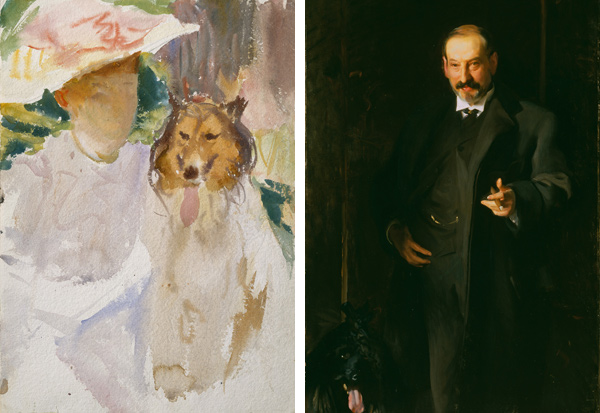
Left: John Singer Sargent (American, 1856–1925). Woman with Collie, after 1890. Watercolor, gouache, and graphite on white wove paper; 13 15/16 x 9 15/16 in. (35.4 x 25.2 cm); mat: 19 1/4 x 14 1/4 in. (48.9 x 36.2 cm). The Metropolitan Museum of Art, New York, Gift of Mrs. Francis Ormond, 1950 (50.130.27). Right: John Singer Sargent (American, 1856–1925). Asher Wertheimer (detail), 1897–98. Oil on canvas; 58 x 38 1/2 in. (147.3 x 97.8 cm); framed: 70 1/2 x 50 3/8 x 5 13/16 in. (179 x 128 x 14.7 cm). Tate: Presented by the widow and family of Asher Wertheimer in accordance with his wishes 1922
It's not clear why Sargent abandoned this composition before completing it, but I love the juxtaposition of the blurry and unresolved face of the woman with the fluid and expressive rendering of the collie. Sargent suggests the dog's soft fur with just a few brushstrokes, and it wasn't until we began installing the paintings that we noticed the amusing comparison of this collie with Asher Wertheimer's poodle, pictured above, both displaying their pink tongues.
Resource
Herdrich, Stephanie L., and H. Barbara Weinberg. "John Singer Sargent in The Metropolitan Museum of Art": The Metropolitan Museum of Art Bulletin, v. 57, no. 4. New York: Metropolitan Museum of Art, 2000.
